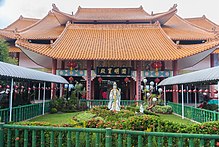| Pu Tuo Si Temple | |
|---|---|
 Pu Tuo Si Temple | |
| Religion | |
| Affiliation | Buddhism |
| District | Kota Kinabalu District |
| Location | |
| Location | Kota Kinabalu |
| State | Sabah |
| Country | Malaysia |
| Geographic coordinates | 5°59′34″N 116°7′0″E / 5.99278°N 116.11667°E |
| Architecture | |
| Type | Chinese temple |
| Date established | unknown |
| Completed | 1980 |
| Website | |
| kkputuosi.org.my | |
Pu Tuo Si Temple (also called as Puh Toh Tze Temple or Poh Toh Tse)[1] is a Buddhist temple located off Tuaran Road in Kota Kinabalu, Sabah, Malaysia. The temple was built in 1980 with a statue of Guanyin located in the entrance. It is the main Chinese temple for the city. In 2013, the temple received a total of RM115,000 from the federal government to finance its on-going renovation.[2]
Features
[edit]The temple main hall is called Daxiong Baodian (大雄宝殿). At the main altar, there is a big statue of Buddha, with a statue of Guanyin in the left and Da Shi Zhi in the right.[3]
-
Guanyin statue.
-
Inscription about the temple.
-
The Laughing Buddha of Budai.
-
A devout praying in the temple.
References
[edit]- ^ Lonely Planet; Simon Richmond; Cristian Bonetto; Celeste Brash; Joshua Samuel Brown; Austin Bush; Adam Karlin; Shawn Low; Daniel Robinson (1 April 2013). Lonely Planet Malaysia Singapore & Brunei. Lonely Planet. pp. 690–. ISBN 978-1-74321-633-0.
- ^ "Federal aid for Likas temple and church". Daily Express. 22 March 2013. Retrieved 27 September 2016.
- ^ Chee-Beng Tan (1983). "Chinese Religion in Malaysia: A General View". University of Malaya, Asian Folklore Studies. Nanzan Institute for Religion and Culture, Nanzan University, Japan. p. 21/36 (237). Archived from the original on 27 September 2016. Retrieved 27 September 2016.
External links
[edit] Media related to Puh Toh Tze Temple Kota Kinabalu at Wikimedia Commons
Media related to Puh Toh Tze Temple Kota Kinabalu at Wikimedia Commons- (in Chinese) Official website






Well, that’s interesting to know that Psilotum nudum are known as whisk ferns. Psilotum nudum is the commoner species of the two. While the P. flaccidum is a rare species and is found in the tropical islands. Both the species are usually epiphytic in habit and grow upon tree ferns. These species may also be terrestrial and grow in humus or in the crevices of the rocks.
View the detailed Guide of Psilotum nudum: Detailed Study Of Psilotum Nudum (Whisk Fern), Classification, Anatomy, Reproduction